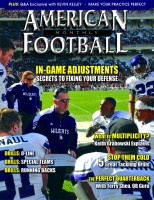Article CategoriesAFM Magazine
|
AFM Subscribers Ask with Pulaski Academy (AR) Head Coach Kevin Kelley© More from this issueAs AFM reported in April’s cover feature, “Mad Genius”, Coach Kevin Kelley of Pulaski Academy (AR) has an unorthodox approach to the game. His team never returns a punt, they almost never punt themselves, they kick off onsides virtually every time and they usually go for a two-point conversion. For Kelley, the unconventional strategy has worked with a 49-7 record over the last four years and multiple state championships. Many AFM subscribers had questions for Coach Kelley about his unusual philosophy and strategy. Q. How many different onside kicks do you have for opponents to prepare for and how much time do you spend practicing the different kicks and recovery skills in both pre-season camp and during the season? Brad Burchfield, Head Coach, Bishop Hartley High School (OH).
|
|
|||||||
| HOME |
MAGAZINE |
SUBSCRIBE | ONLINE COLUMNISTS | COACHING VIDEOS |
Copyright 2025, AmericanFootballMonthly.com
All Rights Reserved





